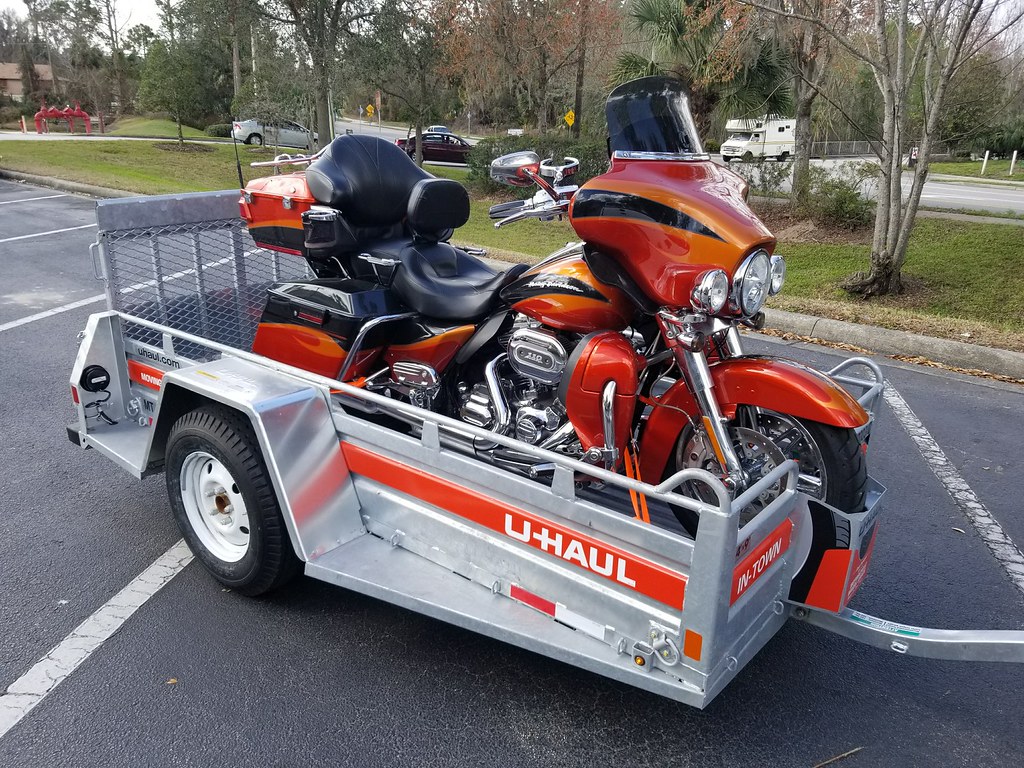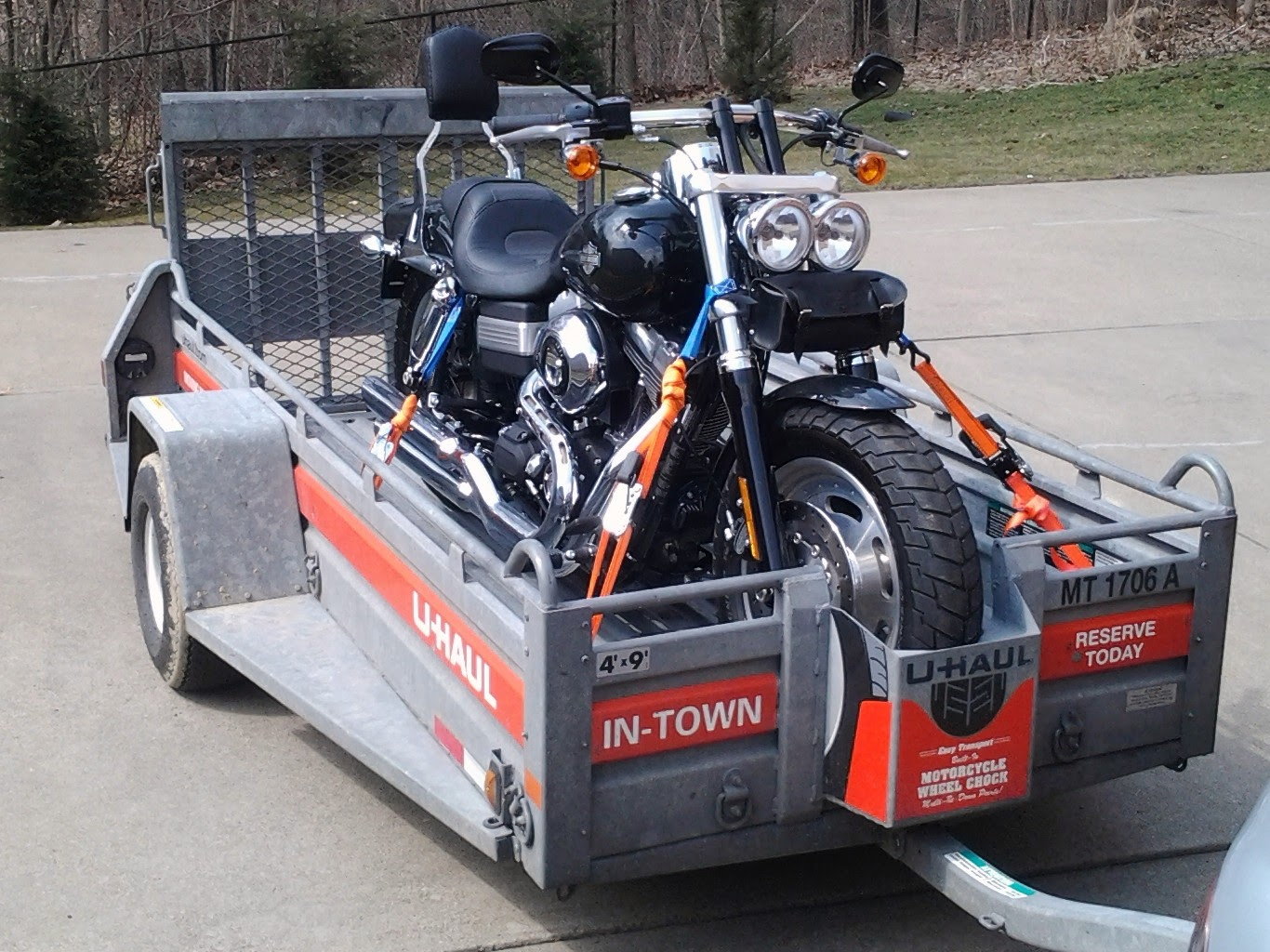U-Haul Motorcycle Trailer: Your Comprehensive Guide to Safe and Easy Hauling

U-Haul Motorcycle Trailer: Your Comprehensive Guide to Safe and Easy Hauling
For motorcycle enthusiasts, the need to transport a beloved two-wheeler can arise for many reasons: a cross-country move, a trip to a distant rally, bringing home a new purchase, or even getting a broken-down bike to the shop. While specialized motorcycle transport services exist, they often come with a hefty price tag. This is where the U-Haul motorcycle trailer steps in as a practical, affordable, and readily available solution.
U-Haul, a household name in moving and storage, offers a reliable fleet of trailers that are perfectly suited for hauling motorcycles. This comprehensive guide will delve into everything you need to know about U-Haul motorcycle trailers, ensuring your valuable ride arrives safely at its destination.
I. Why Choose a U-Haul Motorcycle Trailer?
Opting for a U-Haul trailer for your motorcycle transport needs comes with a host of advantages, making it a popular choice for riders nationwide:
- Convenience and Accessibility: With thousands of locations across North America, U-Haul trailers are incredibly easy to find and rent. This widespread availability means you can often pick up and drop off a trailer at locations convenient to your journey, including one-way rentals for long-distance moves.
- Affordability: Compared to professional motorcycle shipping services or purchasing your own dedicated trailer, renting a U-Haul trailer is a significantly more cost-effective option, especially for infrequent use.
- Purpose-Built Features: While U-Haul doesn’t offer a trailer exclusively labeled "motorcycle trailer," their 5×9 utility trailer with a low deck and integrated ramp is ideally suited for bikes. These features simplify the loading process and enhance security.
- Safety and Reliability: U-Haul maintains its fleet to high standards, ensuring trailers are roadworthy and equipped with essential safety features like reliable tires, working lights, and sturdy construction.
- Versatility: These trailers can accommodate a wide range of motorcycles, from dirt bikes and sport bikes to heavy cruisers and touring models, provided they fit within the weight and dimension limits.
II. Understanding the U-Haul Motorcycle Trailer Model
The primary U-Haul trailer model recommended and commonly used for motorcycles is the 5×9 Utility Trailer with a Loading Ramp. It’s important to understand its specifications to ensure it meets your needs:
- Dimensions:
- Deck Size: Approximately 5 feet wide by 9 feet long. This provides ample space for most single motorcycles, and even some smaller bikes might fit two abreast if carefully positioned.
- Overall Length: Around 13 feet, including the tongue.
- Deck Height: A crucial feature for motorcycles, the low deck height (typically around 18-20 inches from the ground) significantly reduces the incline of the loading ramp, making it easier and safer to load your bike.
- Weight Capacity: These trailers typically have a maximum load capacity of around 1,800 to 2,000 pounds. It’s vital to check your motorcycle’s wet weight and ensure it falls well within this limit, leaving room for the trailer’s own weight and any additional gear.
- Integrated Loading Ramp: This is the most defining feature for motorcycle transport. The ramp is usually located at the rear of the trailer, often folding up or sliding out for easy deployment. Its width and sturdy construction are designed to support the weight of a motorcycle and rider (or person walking the bike).
- Tie-Down Points: The trailer bed will feature several robust tie-down points, typically D-rings or similar hooks, strategically placed to allow for secure strapping of your motorcycle from multiple angles.
- Tires and Lighting: Equipped with radial tires for stable towing and standard four-flat electrical connectors for brake lights, turn signals, and running lights, ensuring legal and safe operation.
It’s crucial to note that these are open utility trailers, not enclosed motorcycle trailers. While they protect your bike from road grime and debris, they won’t shield it from weather elements or provide the same level of security as an enclosed trailer.
III. How to Rent a U-Haul Motorcycle Trailer
Renting a U-Haul trailer is a straightforward process, but proper planning is key.
- Online Reservation:
- Visit the U-Haul website (uhaul.com).
- Select "Trailers" and then "Utility Trailers."
- Look for the "5×9 Utility Trailer with Ramp" or similar description.
- Enter your desired pickup and drop-off locations, dates, and times.
- You’ll need to input information about your towing vehicle (make, model, year) to ensure it meets U-Haul’s towing requirements.
- Towing Vehicle Requirements: U-Haul has strict safety policies regarding towing. Your vehicle must have:
- Appropriate Hitch: A Class I, II, or III hitch receiver, depending on the trailer’s gross weight. For a motorcycle trailer, a Class II or III is generally recommended.
- Hitch Ball: A 2-inch hitch ball is standard for most U-Haul trailers. Ensure it’s rated for the trailer’s weight.
- Working Electrical Connection: A 4-flat (or 7-pin with adapter) wiring harness for trailer lights.
- Sufficient Towing Capacity: Your vehicle’s manufacturer-rated towing capacity must exceed the combined weight of the trailer and your motorcycle. U-Haul will verify this.
- Working Lights: All lights on your towing vehicle must be functional.
- Brakes: Your vehicle must have properly functioning brakes.
- In-Person Pickup:
- Bring your driver’s license, reservation details, and payment method.
- A U-Haul representative will inspect your towing vehicle to ensure it meets all safety requirements. They will connect the trailer, check the lights, and verify the hitch connection.
- You’ll sign a rental agreement and have the option to purchase supplemental damage coverage (SafeTow).
- Rental Duration: You can rent for a single day, multiple days, or for a one-way trip between different locations. One-way rentals are generally more expensive but offer unparalleled convenience.
IV. Loading Your Motorcycle onto a U-Haul Trailer
Proper loading and securing are paramount to preventing damage to your motorcycle and ensuring a safe journey.
- Preparation:
- Clear the Trailer: Remove any debris or loose items from the trailer bed.
- Gather Tie-Downs: U-Haul does not provide tie-down straps. You’ll need at least four high-quality ratchet straps. Soft ties or handlebar harnesses are highly recommended to prevent scratching your bike’s paint or chrome.
- Position the Trailer: Park the trailer on a flat, level surface. Chock the trailer wheels to prevent movement during loading. Ensure your towing vehicle is in park with the parking brake engaged.
- Check Tire Pressure: Both on the trailer and your motorcycle.
- Using the Ramp:
- Deploy the integrated ramp. Ensure it’s securely seated on the trailer and resting firmly on the ground.
- Spotter Recommended: Have a friend assist you. They can provide balance or guide you.
- Loading Method:
- Walking: The safest method for most. Walk the bike up the ramp under its own power (in first gear, feathering the clutch) or by pushing it, using the front brake to control descent if loading in reverse. Maintain a firm grip on the handlebars.
- Riding (Advanced/Risky): Only attempt if you are very experienced and comfortable. The sudden change in incline and potential for wheel spin can be dangerous.
- Securing the Motorcycle:
- Positioning: Once on the trailer, roll the bike forward until the front wheel is snug against the front rail or a wheel chock (highly recommended, but not provided by U-Haul). Position it centrally over the trailer’s axle for optimal weight distribution.
- Front Tie-Downs:
- Attach soft ties around the lower triple tree or handlebars (avoiding cables/hoses).
- Attach ratchet straps to the soft ties and then to the forward tie-down points on the trailer, pulling forward and outward at an angle.
- Compress the front suspension by tightening the straps until it’s about two-thirds of the way down. This prevents the bike from bouncing and loosening the straps.
- Rear Tie-Downs:
- Attach soft ties around the rear frame, passenger footpeg mounts, or swingarm.
- Attach ratchet straps to the soft ties and then to the rear tie-down points on the trailer, pulling backward and outward.
- Tighten the rear straps, again compressing the suspension slightly, to create opposing forces with the front straps.
- Final Checks: Wiggle the bike to ensure it’s absolutely secure. All straps should be taut, and the bike should not shift. Tuck away any excess strap length to prevent it from flapping in the wind.
V. Safe Towing Practices with a U-Haul Motorcycle Trailer
Towing a trailer requires a different driving approach than solo driving.
- Pre-Trip Inspection: Before every departure (and after the first 10-15 miles), double-check:
- Hitch connection (coupler latched, safety chains crossed and hooked).
- Trailer lights (brake, turn, running).
- Tire pressure on both tow vehicle and trailer.
- All tie-down straps are tight and secure.
- Motorcycle position and stability.
- Weight Distribution: The motorcycle should be centered over the trailer’s axle. Too far forward can put excessive tongue weight on your tow vehicle; too far back can cause dangerous trailer sway. A slight positive tongue weight (5-10% of total trailer weight) is ideal.
- Driving Tips:
- Speed: Reduce your speed, especially on highways and winding roads. Trailer sway increases with speed.
- Braking: Allow significantly more stopping distance. Your tow vehicle’s brakes are working harder.
- Turns: Make wider turns to avoid clipping curbs or other vehicles with the trailer.
- Mirrors: Constantly monitor your side mirrors to check on the trailer and your motorcycle.
- Lane Changes: Plan ahead and execute slowly and smoothly.
- Hills: Downshift early when climbing or descending hills to manage speed and strain on your vehicle.
- Regular Checks: Stop every 100-150 miles to visually inspect the trailer, the motorcycle, and all tie-downs. Straps can loosen due to road vibration.
- Weather Conditions: Be extra cautious in adverse weather. Strong crosswinds can cause significant trailer sway. Rain reduces traction and visibility, further increasing stopping distances.
VI. Important Considerations & Potential Challenges
- U-Haul’s Strict Towing Policy: U-Haul prioritizes safety. If your towing vehicle doesn’t meet their requirements, they will refuse the rental. Do not try to circumvent these rules.
- Insurance: Your personal auto insurance may cover the U-Haul trailer, but it’s essential to confirm with your provider. U-Haul offers "SafeTow" coverage for physical damage to the trailer itself, which is often a wise investment. Your motorcycle’s insurance typically covers it while in transit.
- Licensing and Regulations: Most states do not require a special license to tow a U-Haul motorcycle trailer, but always check your local Department of Motor Vehicles for specific regulations.
- Availability: During peak moving seasons (summer, end of month), trailer availability can be limited. Book well in advance.
- Tie-Downs are Your Responsibility: As reiterated, U-Haul does not provide tie-down straps. Invest in quality ratchet straps (at least 1,000 lbs working load limit) and soft ties.
- Roadside Assistance: U-Haul offers roadside assistance for their trailers, but your towing vehicle’s breakdown is typically covered by your own vehicle’s roadside service or insurance.
U-Haul Motorcycle Trailer Estimated Price Table
U-Haul pricing is highly dynamic and can vary significantly based on location, availability, duration, and demand. The following table provides estimated costs for the 5×9 Utility Trailer with Ramp, the most suitable model for motorcycles.
| Feature/Rental Type | Estimated Cost (USD) | Notes |
|---|---|---|
| Trailer Model | 5×9 Utility Trailer with Ramp | The most common and recommended type for motorcycles due to its integrated ramp and low deck. |
| Daily Rental | $14.95 – $29.95 | Varies significantly by location and current demand. Shorter distances and higher demand can push prices up. |
| Weekly Rental | $80 – $150+ | Often offers a discounted rate compared to multiple daily rentals for longer periods. |
| One-Way Rental | $150 – $400+ | Price is highly dependent on the distance between origin and destination, route popularity, and time of year. Booking well in advance is crucial. |
| Damage Coverage (SafeTow) | $7 – $15+ (per day) | Optional but highly recommended. Covers physical damage to the U-Haul trailer itself, not your motorcycle or tow vehicle. |
| Required Equipment (Not Provided by U-Haul) | Cost (if purchased) | |
| High-Quality Ratchet Straps (4-6 recommended) | $30 – $80 | Essential for securing your motorcycle. Look for straps with a working load limit of at least 1,000 lbs each. |
| Soft Ties / Handlebar Harness | $10 – $30 | Protect your motorcycle’s paint, chrome, and finishes from direct contact with ratchet hooks. |
| Motorcycle Wheel Chock (Optional) | $50 – $150 (if purchased) | While not strictly required, a dedicated wheel chock significantly enhances stability and ease of securing the front wheel. |
| Miscellaneous Costs | Varies | |
| Fuel for Tow Vehicle | Varies | Towing a trailer increases fuel consumption. Factor this into your budget. |
| Hitch Ball (2" diameter) | $10 – $20 | If your tow vehicle does not already have one. Ensure it’s rated for the trailer’s gross weight. |
| Electrical Adapter | $5 – $15 | If your tow vehicle’s wiring harness (e.g., 7-pin) doesn’t match the U-Haul trailer’s connector (usually 4-flat). |
Always confirm current pricing and availability directly with U-Haul for your specific rental needs.
VII. Frequently Asked Questions (FAQ)
Q1: What size U-Haul trailer is best for a motorcycle?
A1: The 5×9 Utility Trailer with a Loading Ramp is the most suitable and commonly used U-Haul trailer for motorcycles. Its dimensions, low deck height, and integrated ramp make it ideal.
Q2: Does U-Haul provide tie-downs for motorcycles?
A2: No, U-Haul does not provide tie-down straps or any securing equipment for your cargo. You must bring your own high-quality ratchet straps and soft ties.
Q3: What do I need to tow a U-Haul motorcycle trailer?
A3: Your towing vehicle needs a proper hitch receiver (Class II or III recommended), a 2-inch hitch ball, a working 4-flat (or 7-pin with adapter) electrical connection for lights, and sufficient towing capacity as rated by your vehicle’s manufacturer.
Q4: Can I load an ATV or UTV on a U-Haul motorcycle trailer?
A4: While the 5×9 utility trailer can physically fit some smaller ATVs or UTVs, you must strictly adhere to the trailer’s weight capacity (around 1,800-2,000 lbs payload). Always verify the weight of your ATV/UTV against the trailer’s limits.
Q5: Is U-Haul’s "SafeTow" insurance worth it for trailers?
A5: Many recommend purchasing SafeTow. It covers physical damage to the U-Haul trailer itself, which can save you from significant out-of-pocket costs if the trailer is damaged while in your possession. It does not cover your motorcycle or towing vehicle.
Q6: How do I know if my vehicle can safely tow the U-Haul trailer?
A6: U-Haul will verify your vehicle’s towing capacity using their internal system. You can also find this information in your vehicle’s owner’s manual or by searching online for your specific make, model, and year. It’s crucial that your vehicle’s rated towing capacity exceeds the combined weight of the trailer and your motorcycle.
Q7: Can I use a U-Haul trailer for an electric motorcycle?
A7: Yes, electric motorcycles can be transported on U-Haul trailers, provided they fit within the trailer’s dimensions and weight capacity. The securing process is identical to that of a gasoline-powered motorcycle.
Q8: What if my motorcycle doesn’t fit on the 5×9 trailer?
A8: If your motorcycle is exceptionally long or wide, or if you need to transport multiple bikes, you might need to consider a larger utility trailer (like a 6×12, though these might not have integrated ramps) or explore specialized motorcycle transport services. Always measure your bike and compare it to the trailer’s bed dimensions.
Conclusion
The U-Haul motorcycle trailer offers a robust, accessible, and economical solution for transporting your motorcycle. Whether you’re moving across states, heading to a distant track day, or simply need to get your bike to the shop, U-Haul provides a reliable option. By understanding the trailer’s specifications, following proper loading and securing techniques, and practicing safe towing habits, you can ensure your motorcycle arrives at its destination without a hitch. Remember, thorough preparation and adherence to safety guidelines are your best tools for a stress-free and successful motorcycle transport experience. Ride safe, and tow smarter!


